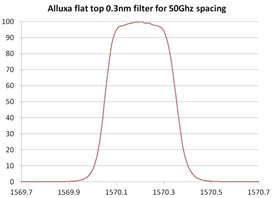Photonics West Recap & Our New Flat Top 1nm Bandpass Optical Filters
Dear Friends, Colleagues and Customers of Alluxa,
At Alluxa, we are proud of our ability to ship volume quantities of the industry’s most aggressively priced precision thin film optical filters. However, we also work on many one-off R&D oriented projects which require challenging the accepted performance limits of thin film technology. Our company is structured to accept both of these types of challenges from our customers and both require innovation, extreme precision, and the dynamism of unconventional thinking.
I am excited to provide the first of a periodic letter updating on our innovations and developments with thin film optical filters, as well as the general happenings at Alluxa, and perhaps provide a few musings on the state of the optical coatings industry and optics industry in general.
Photonics West 2013
Photonics West this year was the most lively and energetic show since the 1990’s. It was good to shake hands and share hugs with so many old friends and colleagues. Hopefully those I missed I can connect with at Laser Munich this spring, which I’m pleased to say I will be attending this year, along with Peter Egerton, Alluxa’s VP of Sales and Marketing.
Our New Flat Top 1nm Band Pass
The product that received the most attention at Photonics West was by far our new flat-top ultra-narrow band pass filter with bandwidth of 1nm or less and 95% peak transmission. The high transmission as well as the flat and square spectral response is what people found the most surprising, which was gratifying feedback given the time and effort we put into developing the technology.
We received many inquiries about how narrow we could build these filters, and the answer of course is that it depends. In the IR at 1550nm we already ship in very large volume a much narrower multi-cavity flat top band pass filter that has a bandwidth of approximately 0.3nm at 1570. This bandwidth would scale to a bandwidth of on the order of 0.1nm in the mid visible, which is obviously much, much narrower than our new product announcement. However, these filters are for telecom applications, and as such only require useful clear apertures of a few millimeters, which dramatically reduces the challenges of controlling uniformity and filter shape. IR wavelengths also tend to create exponentially lower levels of scatter and absorption, crucial to provide high transmission in ultra-narrow bands.

So how narrow can we make a commercially useful filter for a free space optical system at lower visible and NIR wavelengths and a useful size? If I were to extrapolate our plasma hard coating technology to the mid visible with a reasonable clear aperture size of 20mm, I would surmise that the lower limit would be approximately 0.25nm for a flat top 3 to 5 cavity. However, this would certainly not be an inexpensive filter, and would take much fine-tuning and calibration to hit the correct wavelength.
With that in mind, a challenge I would like to issue to the industry is to find us an application that needs and can afford such a filter. Perhaps a LIDAR or communication or emission sensing application? As I mentioned before, Alluxa’s ambition has always been to turn these types of impossible missions into successful projects.
Our future work in ultra-narrow filters will be towards developing capability in the Mid-IR of 2-5 microns and the UV. Stay tuned.
Any questions or comments please send me an email at CEO_Notes@Alluxa.com or schedule a meeting during one of the upcoming industry shows.


